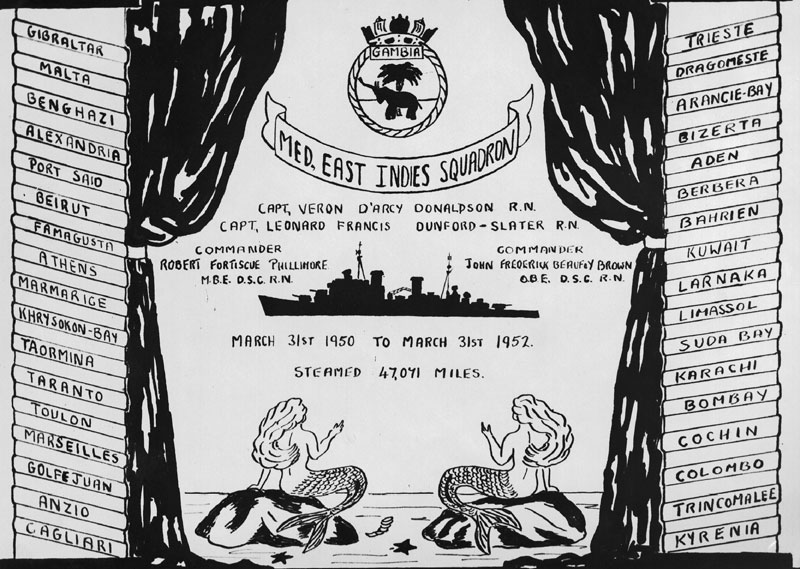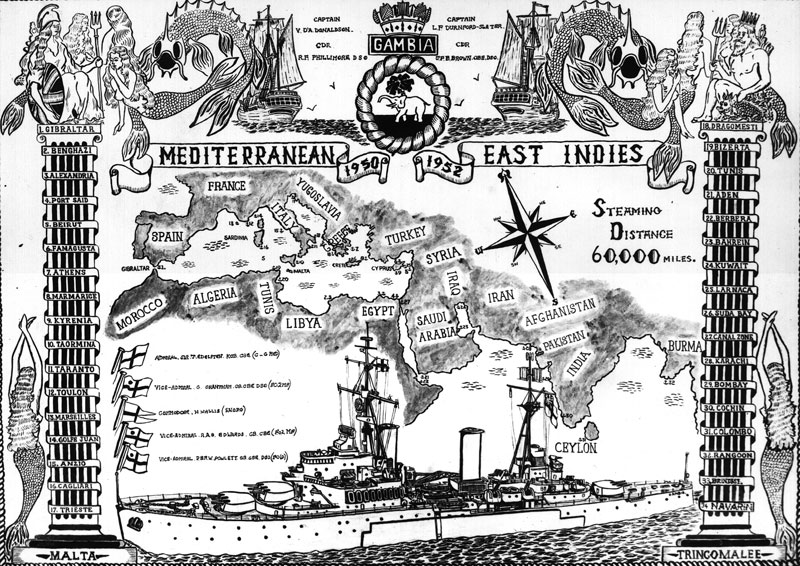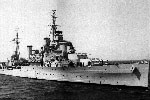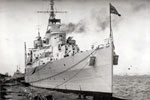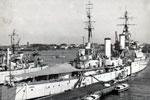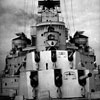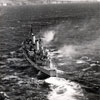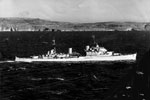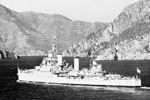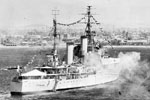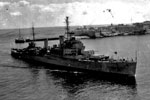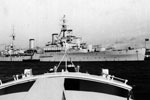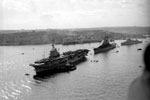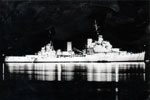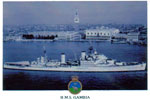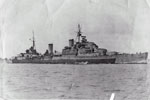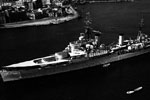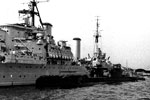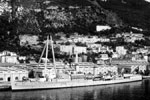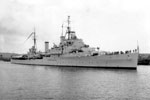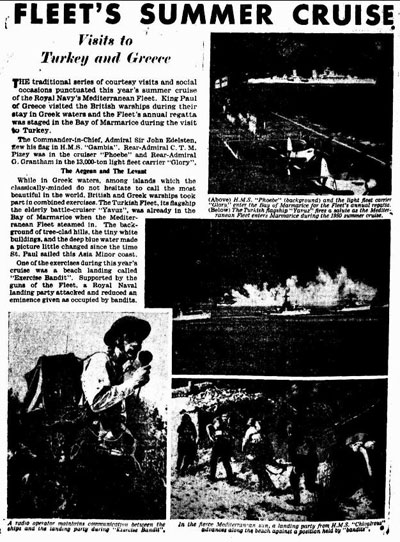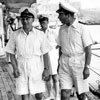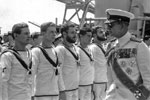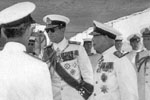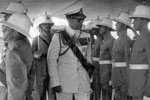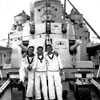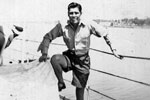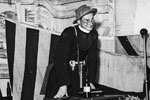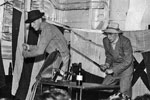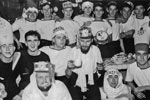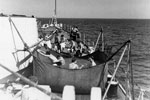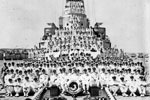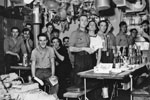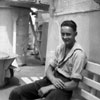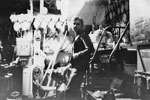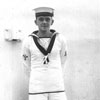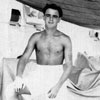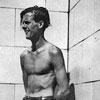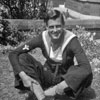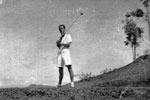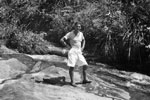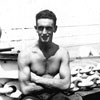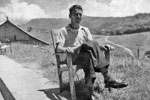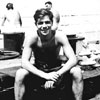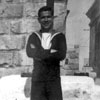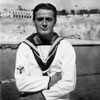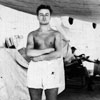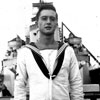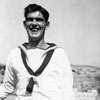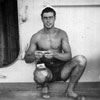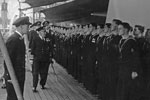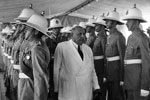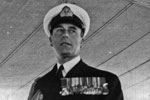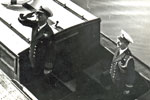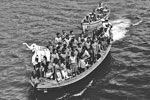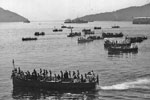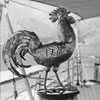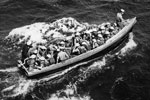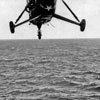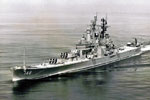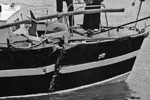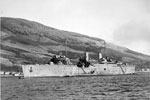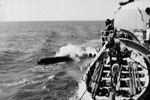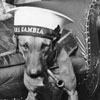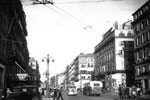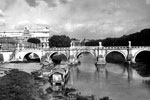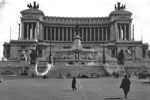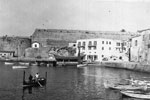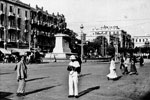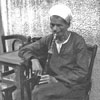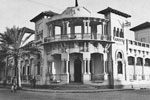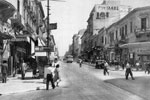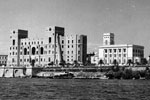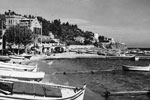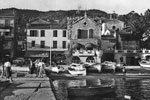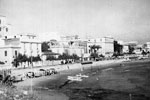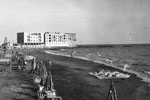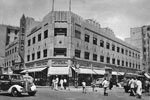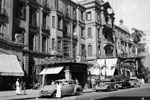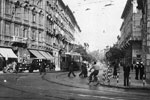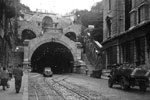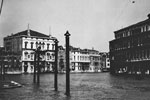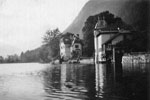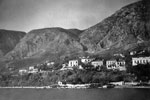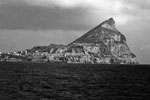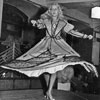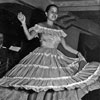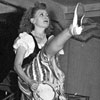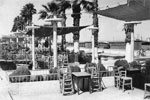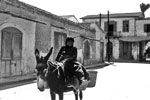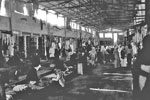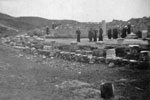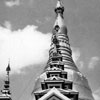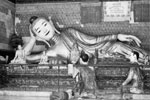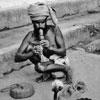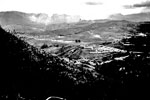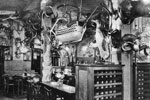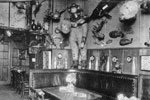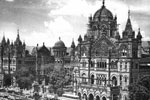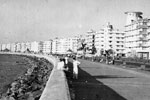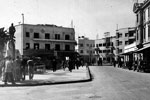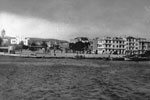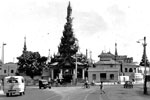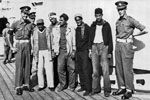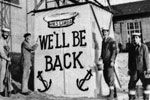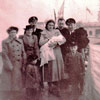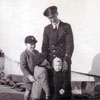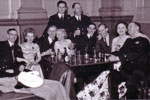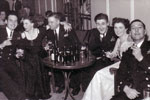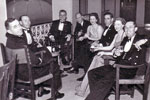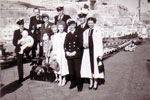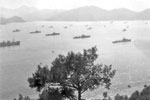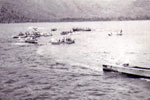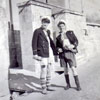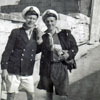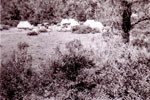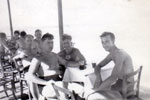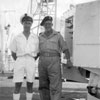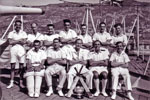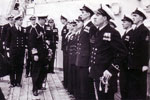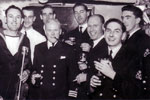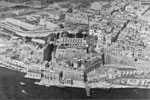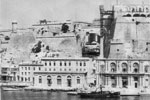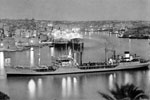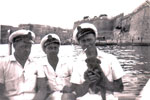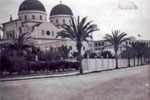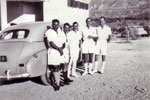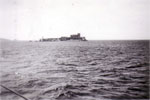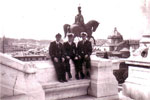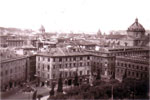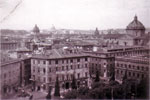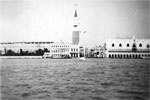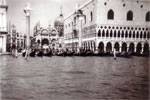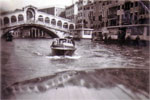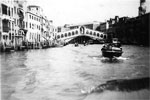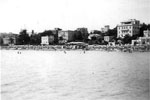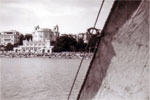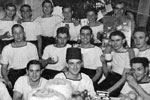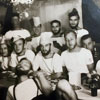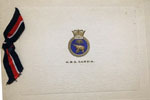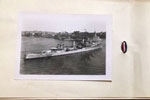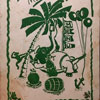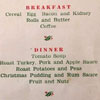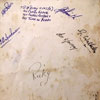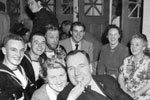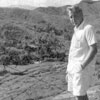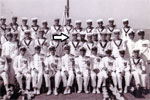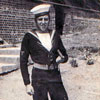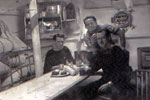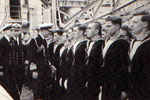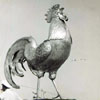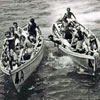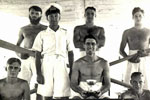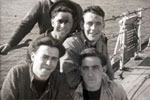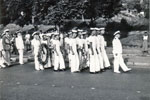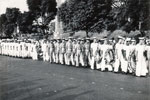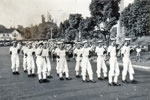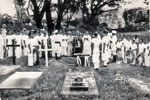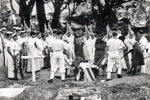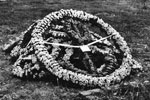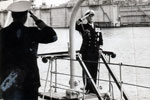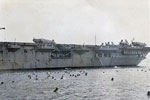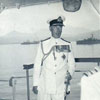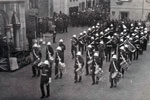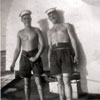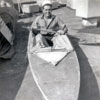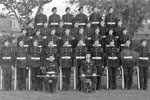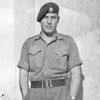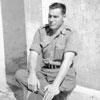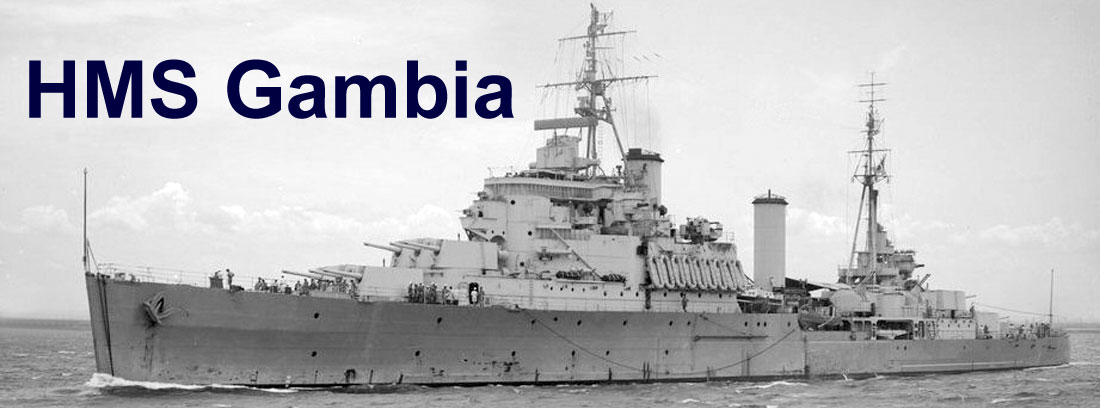
The 1950 to 1952 Commission
This was the commission that my dad, William Henry Thomas, D/SKX852141, served on HMS Gambia as Stoker Mechanic.
Among the places visited on the 1950/2 commission were Gibraltar, Benghazi, Alexandria, Port Said, Beirut, Famagusta, Athens, Marmarice, Khyrosokon Bay, Kyrenia, Taormina, Taranto, Toulon, Marseilles, Golfe Juan, Anzio, Cagliari, Trieste, Malta, Dragomesti, Arancie Bay, Bizerta, Tunis, Aden, Berbera, Bahrein (this was a common spelling in the 1950s for Bahrain), Kuwait, Larnaca, Limassol, Suda Bay, Canal Zone, Karachi, Bombay, Cochin (Kochi), Colombo, Rangoon, Brindisi, Navarin and, of course, Trincomalee.
During this time the captain was V. D. A. Donaldson and the Commander was R. F. Phillimore, MBE, DSC.
John Eilbeck reported in the HMS Ganges Association Gazette that sometime in 1949 to 1950 that some modifications were made to HMS Gambia for the comfort of the crew:
Three cruisers of the Royal Navy, the Swiftsure, Ceylon and Gambia had been refitted and a number of comforts and amenities fitted. All electric bakeries and galleys, refrigerated stowage for fresh fruit and veg, drinking water coolers and ice cream soda bars (the Goffa machine). Bathrooms updated, stainless steel wash-basins, each with a hot and cold water supply, and with shaving light and mirror over each basin. The Laundry extended (more space for ex-patriot Mainland China dhobymen), cinema and SRE provided.
The Canberra Times of Thursday, September 28, 1950 describes the visit of the Mediterranean Fleet to Turkey and Greece.
The text reads:
Fleet's Summer Cruise
Visits to Turkey and Greece
The traditional series of courtesy visits and social occasions punctuated this year's summer cruise of the Royal Navy's Mediterranean Fleet. King Paul of Greece visited the British warships during their stay in Greek waters and the Fleet's annual regatta was staged in the Bay of Marmarice during the visit to Turkey.
The Commander-in Chief, Admiral Sir John Edelsten, flew his flag in HMS "Gambia". Rear Admiral C T M Pizey was in the ciuiser "Phoebe" and Rear-Admiral G Grantham in the 13,000-ton light fleet carrier "Glory"
The Aegean and The Levant
While in Greek waters among islands which the classically-minded do not hesitate to call the most beautiful m the world British and Greek warships took part in combined exercises The Turkish Fleet, its flagship the elderly battle-cruiser "Yavuz", was already in the Bay of Marmarice when the Mediterranean fleet steamed in. The background of tree-clad hills, the tiny white buildings, and the deep blue water made a picture little changed since the time St. Paul sailed this Asia Minor coast
One of the exercises during this year's cruise was a beach landing called 'Exercise Bandit'. Supported by the guns of the Fleet, a Royal Naval landing party attacked and reduced an eminence given as occupied by bandits.
[The images are not good enough to reproduce but the text to them is:]
(Above) H M S Phoebe (backgound) and the light fleet carrier Glory enter the Bay of Marmarice for the Fleet s annual regatta
(Below) The Turkish flagship Yavuz fires a salute as the Mediterranean Fleet enters Marmarice during the 1950 summer cruise
A radio operator maintains communication between the ships and the landing patty during "Exercise. Bandit".
In the fierce Mediterranean sun, a landing party from H.M.S. "Chivalrous" advances along the beach against a position held by "bandits"
This newspaper clipping from the Yorkshire Post and Leeds Mercury of Thursday, October 5th, 1950.about the papal visit in October 1950 was very kindly sent by Steve McAllister whose grandfather, Alan 'Striker' Goodwin, served on HMS Gambia for this commission.


Papal audience for crew of H.M.S. Gambia
From Our Rome Correspondent
While on an official visit to Italy, members or the crew of H.M.S. Gambia - Hudderslield's adopted cruiser - had an audience of the pope, at Castel Gondolfo. about 15 miles from Rome.
Buses took 200 officers and men from Anzio, where the cruiser was at anchor.
The audience was held tn the private throne room. usually called the Swiss Hall. The beautiful marble room is decorated with religious frescoes in pale subdued tones and at one end stands the Papal throne Of red and gold. Overhead is bas-relief of the Crucifixion. Great windows on one side look down over Lake Albano, hundreds or feet below, and beyond the throne is a vista of smaller audience rooms in marble.
The Commander-in-Chief of the Mediterranean Fleet, Admiral Sir John Edelsten, and Lady Edelsten, with members of his staff and their wives, were received first by the Pope in a smaller hall and then returned to join the officers and men assembled in the throne room.
There the Pope, in a gentle voice, speaking excellent English, addressed the sailors for two or three minutes, reminding them or the good they could do as their duty took them to many parts of the world. He b!essed their absent families and friends. A few had the privilege of a personal greeting. Afterwards the Papal Blessing was bestowed on all present.
"The Navy" of January and March 1952 published two short articles about HMS Gambia. "The Navy" was published by The Navy League, Royal Exchange Building, 54a Pitt Street, Sydney, N.S.W., Australia.
Mediterranean Fleet Manoevres with Greek Navy
Late in September. 1951, a squadron of the Mediterranean Fleet composed of the cruiser HMS Gambia, four frigates, two submarines and one submarine depot ship under the command of Vice-Admiral P. B. R. W. William-Powlett, C.B., C.B.E., D.S.O., carried out joint manoeuvres in the Aegean with ships of the Royal Hellenic Navy. The exercises, under Greek command, was watched by King Paul of Greece from the Greek flagship "Panther". The two forces practiced submarine and convoy evolutions, defence against air attacks and harbour defence in Suda Bay, Crete. The Royal Hellenic Air Force co-operated.
P.M. Pays Tribute to Royal Navy's Work in Middle East
The importance of the Navy's work was acknowledged by the Prime Minister (Mr. Churchill) as HMS Gambia (Captain L. F. Durnford-Slater, R.N.) was returning to Malta on completion of a month's period of strenuous duty at Port Said. He asked the First Sea Lord (Admiral of the Fleet Lord Fraser of North Cape, G.C.B., K.B.E.) to compliment the ship on her good work. "I do so with pleasure, knowing how well the Royal Navy as a whole is getting on with its special tasks in the Canal area," the First Sea Lord signalled to Naval headquarters at Malta, and in passing the message to the Gambia the Commander-in-Chief, Mediterranean (Admiral Sir John Edelsten , K.C.B., C.B.E ), added the words "Well done."
The following appeared in the Globe and Laurel, The Journal of the Royal Marines, Volume LX, No. 2, March/April 1952
We sailed from Grand Harbour for Port Said on 15th December, arriving on Tuesday (18th). We were given a berth in the stream, and during the middle watch the wind suddenly increased, parting three manillas securing our stern. Lower deck was cleared and the ship was "handraulically" returned to the buoy long before a tug arrived to give us a hand. Later the same day the wind abated, allowing Liverpool to leave Port Said for Malta, while we returned to our duties of organizing the shipping at the north end of the canal. During the next few days we returned to the familiar routine of Duty Section, escorts, and so on. At the same time, rehearsals for the ship's concert, in which we were to provide a troop of "hairy fairies," were led by Sergt. Scoggins; Marines could be seen constructing wands, wings and frilly things. The concert was presente with great success on five nights, and the Royal fames played a noble part.
After Christmas a .22 rifle Inter-Part Competition was organised, our contribution being three teams of three. The final saw an exciting shoot between the Q.D. and the R.M. "B," resulting in a narrow victory for Cpl. Prince, Mnes. Joyce and Burgess. Early in the New Year the Canal Company employees declared a general strike, and the Emergency Platoon was briefed ready to land at a moment's notice. This, we were told, was likely to be a regular performance until an unpopular overseer was dispensed with, but although the strikes continued daily the platoon was not required again.
We left Port Said for Karachi and the East Indies Station on 13th January, calling at Aden en route. While at Karachi, our rifle team collected some trophies. We are now moving south to Bombay. T.B. & A.E.A.
There had been growing anti-British sentiment in Egypt since the end of WWII. By 1950, it was also growing increasingly violent. This cutting comes from The Battalion, the newspaper of Texas A&M University students of Friday, October 19, 1951...
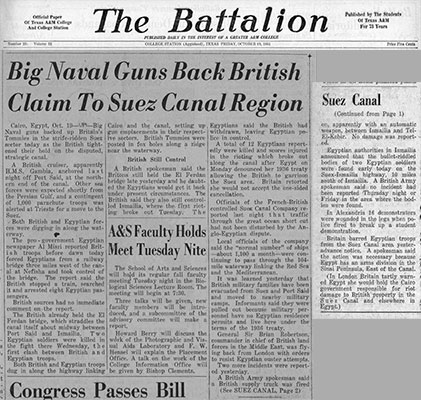
Big Naval Guns Back British Claim To Suez Canal Region
Cairo, Egypt, Oct. 19 (AP) Big Naval guns backed up Britain’s Tommies in the strife-ridden Suez sector today as the British tightened their hold on the disputed, strategic canal.
A British cruiser, apparently H.M.S. Gambia, anchored last night off Port Said, at the northern end of the canal. Other sea forces were expected shortly from the Persian Gulf, and a contingent of 1,000 parachute troops was alerted at Trieste for a move to the Suez.
Both British and Egyptian forces were digging in along the waterway.
The pro-government Egyptian newspaper Al Misri reported British troops before dawn today forced Egyptians from a railway bridge three miles west of the canal at Nefisha and took control of the bridge. The report said the British stopped a train, searched it and arrested eight Egyptian passengers.
British sources had no immediate comment on the report.
The British already held the El Ferdan bridge, which straddles the canal itself about midway between Port Said and Ismailia. Two Egyptian soldiers were killed in the fight there Wednesday, the first clash between British and Egyptian troops.
Both British and Egyptian troops dug in along the highway linking Cairo and the canal, setting up gun emplacements in their respective sectors. British Tommies were posted in fox holes along a ridge near the waterway.
British Still Control
A British spokesman said the Britons still held the El Ferdan bridge late yesterday and he doubted the Egyptians would get it back under present circumstances. The British said they also still controlled Ismailia, where the first rioting broke out Tuesday. The Egyptians said the British had withdrawn, leaving Egyptian police in control.
A total of 12 Egyptians reportedly were killed and scores injured in the rioting which broke out along the canal after Egypt on Monday denounced her 1936 treaty allowing the British to garrison the Suez area. Britain retorted she would not accept the one-sided cancellation.
Officials of the French-British controlled Suez Canal Company reported last night that traffic through the great ocean short cut had not been disturbed by the Anglo-Egyptian dispute.
Local officials of the company said the "normal number" of ships - about 1,100 a month - were continuing to pass through the 104- mile waterway linking the Red Sea and the Mediterranean.
It was learned yesterday that British military families have been evacuated from Suez and Port Said and moved to nearby military camps. Informants said they were pulled out because military personnel have no Egyptian residence permits and live here under the terms of the 1936 treaty.
General Sir Brian Robertson, commander in chief of British land forces in the Middle East, was flying back from London with orders to resist Egyptian ouster attempts.
Two more incidents were reported yesterday. A British Army spokesman said a British supply truck was fired on, apparently with an automatic weapon, between Ismailia and Tel-El-Kebir. No damage was reported.
Egyptian authorities in Ismailia announced that the bullet-riddled bodies of two Egyptian soldiers were found early today on the Suez-Ismailia highway, 10 miles south of Ismailia. A British Army spokesman said no incident had been reported Thursday night or Friday in the area where the bodies were found.
In Alexandria 16 demonstrators were wounded in the legs when police fired to break up a student demonstration.
Britain barred Egyptian troops from the Suez Canal area yesterday advance notice. [sic] A spokesman said the action was necessary because Egypt has an arms division in the Sinai Peninsula, East of the Canal.
(In London Britain tartly warned Egypt she would hold the Cairo government responsible for riot damage to British property in the Suez Canal and elsewhere in Egypt.)
The Battalion, Friday, October 19, 1951
Page 1 - Image version | OCR version
Page 2 - Image version | OCR version
This was on this commission that my dad, William Henry Thomas, D/SKX852141, served on HMS Gambia as Stoker Mechanic. Dad was born on October 21, 1930 and volunteered for 12 years service in the Royal Navy on February 3, 1948, he was accepted for Special Service and started training on May 13. Special Service meant he signed for seven years with the Fleet and five years in the RNR always on immediate call. Duncan Sands, the defence minister in about 1958 gave everyone in the RNR a voluntary discharge but placed them in another reserve, the only difference was that they didn't get paid the princely sum of one shillings and sixpence a week which they got in RNR.
From his Certificate of Service he trained on HMS Royal Arthur, Raleigh and Drake as a stoker, from there he went to HMS Wrangler as Stoker Mechanic in 1949, joining HMS Gambia in 1950 for two years. He became a Royal Navy Swimming Instructor in 1951 and got his first Good Conduct badge on October 21, 1952. In 1953 he joined HMS Warrior, becoming an Engineering Mechanic. He also spent nearly a year, between his time on HMS Gambia and HMS Warrior, at HMS Orion.
HMS Orion was originally a cruiser, but was scrapped in 1949. The name passed to the whole of the Reserve Fleet in Devonport dockyard and the operation was run from two ships berthed at the Saltash end of the dockyard. The monitor HMS Roberts was the administrative headquarters with HMS Dodman Point berthed alongside her for accommodation. Dodman Point was an old depot ship. Usually, a draft chit to the Reserve Fleet meant that sailors were waiting for another seagoing ship, or another foreign commission.
His time was spent with the Mediterranean and Far Eastern Fleet, as a result he visited most of the Southern European nations, France, Portugal, Spain, Italy, Sicily, Germany and Austria, the countries along the Adriatic coast - obviously not Yugoslavia (it was communist) but Greece, Crete and Malta. Through the Suez Canal to Egypt and Saudi Arabia. Around the Indian Ocean to Pakistan and India, Ceylon (Sri Lankra) and Thailand. Into the Pacific and the Sea of Japan for Hong Kong, Korea, Vietnam and Japan. He also took the long way around Africa, Crossing the Line on the way round the Cape.
On July 20, 1955 received the UN Korea and Korean medals for his service there on HMS Warrior. Although he signed up for twelve years, defence cuts meant his service was reduced and he was discharged from service on October 21, 1955 having spent very nearly 7 and a half years in the Royal Navy.
The following photos come from the albums of his time on HMS Gambia, with some from other sources as illustrations and reference.
Some Egyptian factions merely tolerated the English and other Allies in Egypt during WWII. After the war was over feelings began to change towards the Allies and although the Egyptian Royal family remained friendly towards Britain, the Government didn't. In 1952 things came to head when the Prime Minister, Nahas Pasha, repealed the 1936 treaty which gave the British control of the Suez Canal. King Farouk dismissed the prime minister, starting anti-British riots which were put down by the Egyptian army.
In November 2001, Ray Holden very kindly sent me this email :-
I served on HMS Liverpool the Flagship of 1st Cruiser Squadron in the Med in 1951. Gambia was another ship in our squadron and we very often worked together on exercises. In early 1952 HMS Mauritius was on her way back to UK from the Far East and the troubles in Egypt blew up as she was going through the Suez Canal. She was retained at Port Said to protect Navy House. She was relieved two weeks later by HMS Liverpool and it was our job to protect merchant ships who sailed through the canal in the form of boarding parties, our marines guarded Navy House. After a three month stint we were relieved by HMS Gambia.
George Bell served on HMS Gambia as Electrical Petty Officer for her 1950/52 Commission.
On October 16, 2003, George recorded an oral history for the Imperial War Museums (IWM 25545). In parts 6 and 7 of the interview George describes his time on HMS Gambia and I have extracted the relevant sections. In this extract George descibes how he joined HMS Gambia, the places she visited during the commission, converting the aircraft hanger to a Petty Officer's Mess, sight of the Camel Corps in North Africa, and his part in the 1952 fleet regatta.
Alan L. Clements (Clem) was born in 1921 and joined the Royal Navy as a boy-apprentice at Fisgard from the Royal Hospital School in 1936 but was drafted to HMS Caledonia, Rosyth in 1937. The apprenticeship was shortened on the outbreak of war and he went to HMS Defiance at Devonport before getting HMS Duke of York as his first ship. He got into missiles in 1952 and went to Woomera, South Australia to continue R&D with GEC on Seaslug & Seadart. Alan served 22 years and was pensioned in September 1961 when he moved to Adelaide.
These images come from Alan who was an Electrical Artificer on the HMS Gambia's 1950/2 commission:
Some of the photos mention the Vernon Club in St James's Bastion, Valletta, Malta. Only the outer facade of the building now survives. When Malta gained independence in 1964, the Maltese Government decided to establish a central bank, and in July 1968, the Bank acquired the Vernon Club on St James Bastion in Valletta. The outer facade was kept, but the inside of the building was redesigned, gutted and rebuilt. The new building opened in February 1971. The Central Bank of Malta website has a history of the building.
The Barrakka Lift is an interesting structure. It was built in 1905. The original lift closed in 1973 and was dismantled in 1983. In 2009 plans were drawn up for a new lift and building started in 2010 and it was opened in 2012.
Alan 'Striker' Goodwin served on HMS Gambia from December 30, 1949 to September 29, 1952 as an electrician. His grandson, Steve McAllister, very kindly sent the following photographs.
Denys Powell served on HMS Gambia from 1949 to 1952 as a Stoker Mechanic. In December 2002, his daughter, Anita Neads, very kindly sent these photos to me.
There was a lot of rough play during the Fleet Regattas for the Cock of the Fleet trophy. Bernard Mouzer, OBE RVM, served on HMS Phoebe during her 1948-1951 commission and sent me the following letter about the 1950 regatta he sent to his wife.
The Regatta this year is being spread over two days with the small ships competing on the first day. The two New Zealand ships win most of their races. With their Maori rowers they are very formidable opposition. But the main contest is on the second day between the bigger ships, Forth, Gambia, Glory and ourselves. Although we are the smallest of the four, with the smallest complement to choose crews from, we fancy ourselves to win the Cock. In the evening before our race I go to the cinema in the waist to see "Under Capricorn."
Wednesday 12. 7.50 is probably the most memorable day of the commission. Phoebe wins the Regatta and is the Cock of the Fleet. We are already looking forward to steaming into Grand Harbour with the huge plywood cock in its prominent place on B turret and of course the Skipper receiving the silver cock trophy from the Admiral.
Phoebe wins quite comfortably. Out of the 8 Seamen's boats we come fourth and our A whaler comes first. So as well as a sore bottom and horny hands I now have a certain amount of satisfaction. Times are faster than last year and the competition keener, encouraged by the New Zealanders.
They (the New Zealanders) are different to us. It can be said for them that they are tremendously high spirited and good humoured and that they go all out to enjoy themselves. However, because of their high spirits they run away with themselves and become hooligans. They're excused a bit because amongst the hooliganism there is nothing but good humour. They don't get nasty. But by nature they're rough and physically they're big, well developed and extremely healthy.
Imagine therefore the consequences when foraging parties from the New Zealand ships come in the black night to pinch our Cock. The wooden one illuminated on B turret. There were also parties from other ships, notably Gambia and Forth. The Captain himself piped "Stand by to Repel Boarders" and when we got up top he was standing on the quarterdeck, drenched to the skin, clad in formal dinner attire, heaving spuds and shouting, "Rally round Phoebes!" All the hoses were going, all the officers were drenched and mostly drunk – spuds, red lead bombs, paint, buckets of gash, and still the Kiwis came. Up the gangway, up the anchor cable, up the booms and in through the ports. They were beaten, drenched, painted and then chucked over the side only to shout back in defiance, "We'll be back you jokers" and back they'd come.
The bridge was teeming with them. One of them was thrown off the flag deck onto an awning and then over the foc'sle. A couple were taken to sick bay but thanks to good providence nobody was seriously hurt. One cheeky b climbed in through a port, put all the plugs in the officers bathroom, turned all the taps on, took all the tap tops off and stowed them in a wine box. All the cabins in that region were flooded. What a laugh! One of them pinched one of the Captain's brass dolphins ( huge things) dived over the side with it and put it in his boat as booty. How he managed to swim with it I don't know.
At the height of it all the Captain had "The Cease Fire" sounded and everything stopped as suddenly as it started. A bedraggled officer from another ship still in his formal dinner dress, dragged himself up the gangway from where he had been heaved over the side and said, "Now I can go ahead with the social call I came to pay!" On the other side of the ship, in Hawea's boat a New Zealander in trunks, covered from head to foot in black paint, wiping himself on our tiddly cotton duck gangway screen said, "Three Cheers for Phoebe. We'll be back about three!"
Well not much happened after that except to pick all the blokes out of the water, and this morning we cleared up the mess. There were spuds, red lead, paint and in big black letters painted on the stern, "Gambia." Now we are shipshape again and it's all over. I know that it is all foolish hooliganism but I can't help admiring the Kiwis for their good humour and gameness. It helped to pass the time and no harm has been done except to the Instructor Lieutenant who has got a black eye. I am so pleased. (He is the man who upset me by being so unhelpful about my request for a correspondance course).
Ken Booth wrote in November 2002
The Gambia was waiting in Bombay in February '52 to go across to Mombasa to escort Princess Elizabeth and Phillip to Australia after their holiday in Kenya, but when the King died they flew home. We then became permanent members of the East Indies fleet until we sailed for home via the Med. where we took the trophy "Cock of the Fleet" as we passed through. It was hard work for those competing boats crews though.
This comes from the original HMS Gambia Association website:
Gambia re-joined the Mediterranean Fleet to take part in the first part of the Summer Cruise and promptly carried off the "Cock" in the Heavy ship Pulling Regatta.
The Regatta was held at Argostoli on July 9 and 10 [1952] and in the fifteen races Gambia obtained seven firsts, six seconds and three thirds. She secured the "Cock" by a lead of 17 points from her closest rival, H.M.S. Euryalaus, after an exciting battle and thus two Devonport ships were able to inform the Home Port that a "proper job" had been done.
The worst part of this commisssion was the death by drowning of Able Seaman John "Jock" Kerr in a boating accident in Lake Victoria, Rangoon, Burma in 1951.

Roy Sankey writing from australia said that "Jock Kerr was a shore going oppo of mine. I was in the boating party on the day it happened. I swam a half to three quarters of a mile to the American Embassy Residence to get a message to Gambia that we needed divers."
Bill Price said that "I remember Able Seaman Kerr and I believe he used to be on my watch before we went on the Bridge. I also did Ceremonial Guard. When the poor chap drowned it was a very sad occasion at the time."
Ken Booth said that "the funeral was the longest procession ever seen in Rangoon." Both he and Dennis Kirkley mentioned that some of Jock's possessions were auctioned off with many items getting several pounds when they were only worth pennies. Dennis wrote that "The Leading Hand of the Mess was L/S Welsby. The Lake was rumoured to claim a life a year. Jock was buried with full Naval Honours on an Old Japanese Gun Carriage, and a big unit of Burmese Naval Ratings in Rangoon. His gear raised about a £100 I think? This money and his photos were sent to his next of kin in Scotland. I don't think we ever received a reply back."
It transpired that Jock's only next of kin was his father, so it is perhaps not surprising they did not get a reply.
Sadly, although much work was undertaken by various groups in Burma, including the Salvation Army and Roman Catholic Padres, the original grave of Jock Kerr is no longer to be found, as the graveyard has been moved no less than three times over the years.
Since the 1950s, Victoria Lake has been renamed Inya Lake, and Rangoon is now known as Yangon.
Slim Welsby was a Leading Seaman on the 1950/52 commission. Here he is assisting with a jackstay transfer of an admiral in the Mediterranean Sea in 1950.
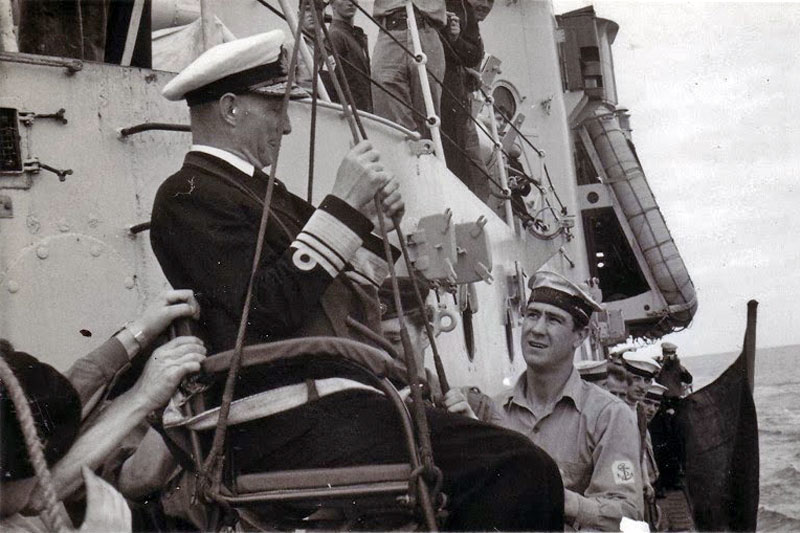
This set of photos is a bit of mystery. Many of them have no or very little captioning. I do not know who supplied most of them but some were submitted by Jerry Sullivan, ex Royal Canadian Navy.
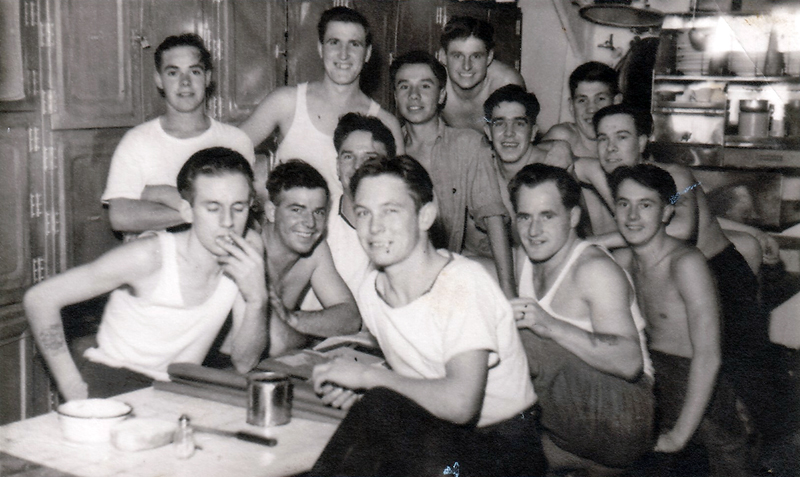
Click on the image above to show or hide the names. I do not know who submitted the image or what mess this is.
I'm not sure if this is the correct year, but it seems to fit here as well as anywhere else as Walter (Tom or Tommo) Thomas remembered the collision with HMS Phoebe on Monday, October 16, 1950.
In July 2002, I got an email from Karen Thomas who provided some information about her grandad Walter (Tom or Tommo) Thomas. She wrote that:
He served on as a Royal Marine with 40 Commando from May 1946 to February 1960. His service number was PO/X662.
He served aboard the Gambia for around 2½ years. Whilst he was on board there was another Marine killed. His name was Paddy Bray and he was squashed. Also, whilst he was aboard the Gambia it ran into a ship that was passing mail. The mail ship pulled ahead in front of the Gambia and they collided. She had to go back into dry-dock in Malta for repairs.
He was aboard the Vanguard for around 14 months. 1948 - 1949 approx. The Vanguard was due to take King George VI to Australia but the plans changed at the last minute as he became ill.
He had a particularly friend, Ronald (Tex) King, who left at the same time as Tom. Tex bought himself out and was last known to be planning to live in Australia.
The collision Karen mentions would have been the one HMS Gambia had with HMS Phoebe on Monday, October 16, 1950.
I didn't think anything of it at the time, but recently did some research. Royal Marine E. T. Bray did not die on HMS Gambia but on HMS Vanguard. Returning to Grand Harbour, Malta on October 21, 1948, Bray was crushed between a 5.2 inch gun turret and another part of the ship. Bray was aged just 20 and his mother, Mrs Margaret Bray, lived at School House, Monkstown, County Durham. Bray is buried in in Kalkara Naval Cemetery, Malta.
There have been eleven ships named HMS Vanguard. Some of the ships had some nasty accidents. The 8th HMS Vanguard was sunk on August 27, 1875 after a collision with her sister ship, HMS Iron Duke. The 9th, suffered a magazine explosion on July 9, 1917. She sank almost instantly, with the loss of 843 of the 845 men aboard. The 11th HMS Vanguard is a nuclear-powered Trident ballistic missile-armed submarine. On February 4, 2009, the submarine collided with the French submarine Triomphant in the Atlantic.
Unfortunately the Internet Archive did not capture all the images from the old HMS Gambia Association website. All I could retrieve were these thumbnails.
This group of photos were contributed by Telegraphist Bill Onslow:
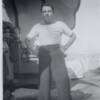 Some attraction to the Four Inch Station?
Some attraction to the Four Inch Station? Telegraphist Bill Onslow
Telegraphist Bill Onslow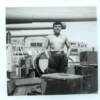 Somewhere in Dry Dock?
Somewhere in Dry Dock?This group of photos were supplied by Brian Hughes who was a chairman of the HMS Gambia Association.
 Brian astride a 6" barrel, hope Guns didn't spot you Brian!
Brian astride a 6" barrel, hope Guns didn't spot you Brian!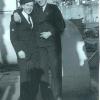 Brian Hughes and Cliff Hewitt
Brian Hughes and Cliff Hewitt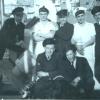 An unknown group
An unknown group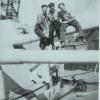 An unknown trio
An unknown trioAll that is known about this group of photos is that some of them were supplied by Jerry or Gerry Sullivan, ex Royal Canadian Navy
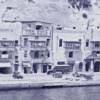 HMS Iron Duke at Valletta Harbour, Malta in 1951. This photo was submitted by Jerry or Gerry Sullivan, ex Royal Canadian Navy. The Iron Duke was apparently run by an old ex three badge chief tiffy.
HMS Iron Duke at Valletta Harbour, Malta in 1951. This photo was submitted by Jerry or Gerry Sullivan, ex Royal Canadian Navy. The Iron Duke was apparently run by an old ex three badge chief tiffy.I think there may be a mistake with the original captioning of this photo. The Iron Duke was a WWI battleship that was scrapped in 1946. There is a frigate named Iron Duke but that was not commissioned until 1993
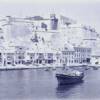 HMS Iron Duke at Valletta Harbour, Malta in 1951. This photo was submitted by Jerry or Gerry Sullivan,ex Royal Canadian Navy. The Iron Duke was apparently run by an old ex three badge chief tiffy.
HMS Iron Duke at Valletta Harbour, Malta in 1951. This photo was submitted by Jerry or Gerry Sullivan,ex Royal Canadian Navy. The Iron Duke was apparently run by an old ex three badge chief tiffy.I think there may be a mistake with the original captioning of this photo. The Iron Duke was a WWI battleship that was scrapped in 1946. There is a frigate named Iron Duke but that was not commissioned until 1993
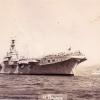 HMCS Magnificent and HMS Surprise
HMCS Magnificent and HMS Surprise This is a key to a photo by Jan Birch. Unforunately, I do not know which photo nor can read this key
This is a key to a photo by Jan Birch. Unforunately, I do not know which photo nor can read this keyThis group of photos were submitted by Peter Evans who served on HMS Gambia as an Ordinary Seaman from July 1951 to 1952. Like the others, all I could retrieve were these thumbnails.
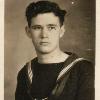 Peter Evans. This is the picture from his driving licence
Peter Evans. This is the picture from his driving licence This photo from Peter Evans shows the Forecastle (foc's'le) Division
This photo from Peter Evans shows the Forecastle (foc's'le) Division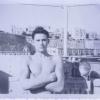 Peter Evans in Malta
Peter Evans in Malta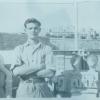 George Walker
George Walker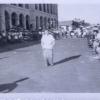 Jan Cook
Jan Cook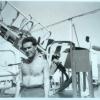 Taff Morgan
Taff Morgan Taff Morgan and oppo
Taff Morgan and oppo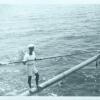 Thompson not out on a limb, more out on a Boom!
Thompson not out on a limb, more out on a Boom!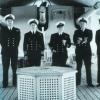 Christmas Day on the Quarterdeck
Christmas Day on the Quarterdeck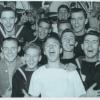 Christmas Day in the mess
Christmas Day in the mess Phoenicia Hotel, Valletta, Malta
Phoenicia Hotel, Valletta, Malta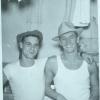 Blackie and Stokes
Blackie and Stokes Customs House, Port Said
Customs House, Port Said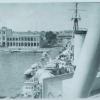 Navy House, Port Said
Navy House, Port Said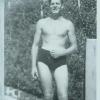 Johnny Sharp, Bombay
Johnny Sharp, Bombay USS Duxbury Bay
USS Duxbury Bay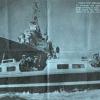 Thug Tug on patrol in the Suez Canal
Thug Tug on patrol in the Suez Canal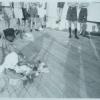 Snake Charmer, Karachi, note that everyone gives the snake charmer a wide berth
Snake Charmer, Karachi, note that everyone gives the snake charmer a wide berth All smiles
All smiles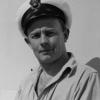 An unknown chief
An unknown chief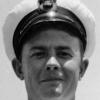 Another unknown chief
Another unknown chief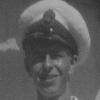 Ronald Frederick May, CERA 2, who lost his life in Malta on August 15, 1953, in a road accident. Ronald served on HMS Gambia from 1949 to 1952 and at the time of his death was serving on HMS Cumberland
Ronald Frederick May, CERA 2, who lost his life in Malta on August 15, 1953, in a road accident. Ronald served on HMS Gambia from 1949 to 1952 and at the time of his death was serving on HMS Cumberland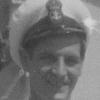 Petty Officer Black
Petty Officer Black